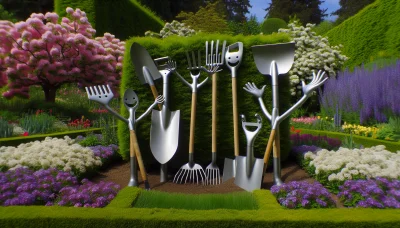Cranesbill Quiz
Test Your Knowledge
Question of
Introduction to Cranesbill
Cranesbill, also known as Geranium, is a diverse group of flowering plants highly regarded in the gardening world for its beauty and resilience. These plants are known for their attractive foliage and flowers that come in a variety of colors including pink, purple, blue, and white. Cranesbill is appreciated for its ability to thrive in a wide range of conditions, from full sun to shade, making it an excellent choice for gardeners looking to add long-lasting color and texture to their landscapes. Additionally, its easy care and ability to attract pollinators like bees and butterflies make it a valuable addition to any garden.
Types of Cranesbill
- Rozanne: Known for its vibrant blue flowers and long blooming period.
- Brookside: Showcases striking deep blue flowers with white centers.
- Bloody Cranesbill (Geranium sanguineum): Features bright magenta flowers and is known for its hardiness.
- Biokovo: A subtle beauty with white to pale pink flowers, often used as ground cover.
- Johnson’s Blue: Offers light blue flowers and is a favorite for its ease of growth and maintenance.
- Max Frei: Boasts deep pink blooms and compact growth, ideal for small spaces.
- Patricia: Distinguished by its large, magenta flowers with black centers, adding a pop of color to any garden.
- Mourning Widow (Geranium phaeum): Known for its dark maroon to almost black flowers, adding a dramatic touch.
- Dusky Cranesbill (Geranium pratense): Features violet-blue flowers and deeply cut leaves, providing texture as well as color.
How to Plant Cranesbill
Planting cranesbill, also known as Geranium, in your garden can add a splash of color and beauty. Here are the simple steps to get you started:
- Choose the Right Location: Cranesbill thrives in a spot with full sun to partial shade. Ensure the soil is well-draining.
- Prepare the Soil: Loosen the soil to about 12-15 inches deep and mix in some compost or aged manure to enrich it.
- Planting: Dig a hole twice the size of the root ball. Remove the plant from its container, gently tease the roots, and place it in the hole. Fill the hole with soil and press firmly.
- Watering: Water the plant thoroughly after planting. Continue to water regularly, especially during dry spells, to keep the soil moist but not waterlogged.
- Mulching: Apply a layer of mulch around the plant to help retain moisture, regulate soil temperature, and reduce weed growth.
- Feeding: Feed your cranesbill with a general-purpose fertilizer in the spring to encourage growth.
- Pruning: Deadhead spent flowers to promote new blooms. You can also cut back the plant in midsummer if it becomes leggy or after the first frost in fall to tidy up the garden.
Caring for Your Cranesbill
- Watering: Keep the soil evenly moist, especially during dry spells. Cranesbills prefer not to dry out completely, but be careful not to overwater as this can lead to root rot.
- Sunlight: Most cranesbill varieties thrive in full sun to partial shade. If you live in a particularly hot climate, aim for a spot that gets some afternoon shade to protect the plants from scorching.
- Soil Requirements: These plants are not overly fussy about soil types but prefer well-draining soil rich in organic matter. A pH that is slightly acidic to neutral is ideal. Amending the soil with compost can help improve soil structure and provide nutrients.
Common Pests and Problems
Cranesbill plants, while being relatively hardy and low-maintenance, can still encounter a few common issues that gardeners should be aware of. One of the primary pests that target these plants are aphids. These small, sap-sucking insects can weaken the plant by feeding on its juices, leading to distorted growth and a decline in health. A strong spray of water from a hose can often dislodge aphids from the plant. For more severe infestations, applying neem oil or insecticidal soap can be effective treatments. Another issue is powdery mildew, a fungal disease that manifests as a white, powdery coating on leaves. Ensuring good air circulation around the plants and avoiding overhead watering can help prevent its occurrence. If powdery mildew does appear, applying a fungicide or a mixture of baking soda and water can help manage the disease. Additionally, slugs and snails may also pose a threat, particularly in moist, shady gardens. They can be deterred by using barriers such as diatomaceous earth or copper tape around the plants, or by setting traps. Regular monitoring and early intervention are key to keeping these common pests and problems in check, ensuring your cranesbill plants remain healthy and vibrant.
Cranesbill Companion Plants
| Plant Name | Benefits |
|---|---|
| Lavender | Repels deer and rabbits; adds fragrance |
| Shasta Daisy | Attracts pollinators; contrasts nicely with cranesbill |
| Yarrow | Attracts beneficial insects; drought-tolerant |
| Sedum | Provides ground cover; attracts pollinators |
| Russian Sage | Adds height and color; repels pests |
| Catmint | Repels rodents; attracts bees |
Conclusion: The Beauty of Cranesbill in Your Garden
Growing cranesbill, or Geranium, in your garden offers a multitude of benefits that extend beyond their undeniable beauty. These hardy perennials are not only easy to care for but also provide a long-lasting display of color from early spring until fall, making them a perfect addition for both novice and experienced gardeners. Their ability to thrive in a variety of soil types and conditions, coupled with their resistance to pests and diseases, makes them an ideal choice for sustainable gardening practices. Furthermore, cranesbills are excellent for attracting pollinators like bees and butterflies, enhancing the biodiversity of your garden ecosystem. Incorporating cranesbills into your garden design can create a vibrant and dynamic landscape that supports wildlife, promotes healthy gardening, and brings joy with their diverse range of colors and forms. Embrace the beauty and benefits of cranesbill in your garden to create a thriving, picturesque outdoor space.












